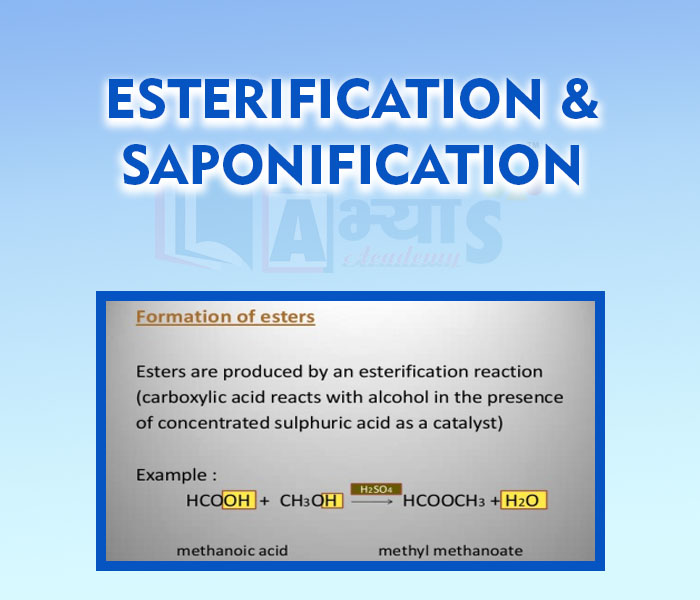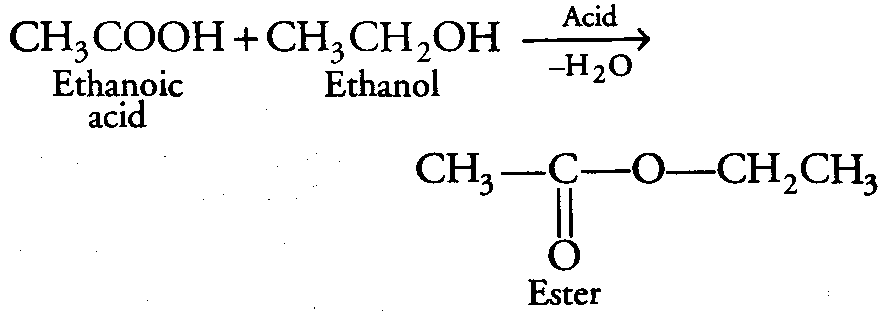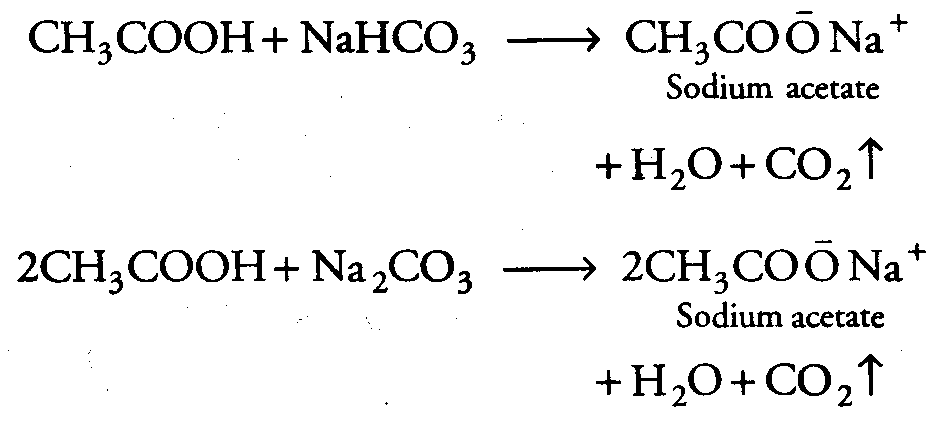Esterification and Saponification







Esterification and Saponification
Esterification and Saponification:
When ethanol (an alcohol) reacts with acetic acid (a carboxylic acid) in the presence of an acid as catalyst a fruity (sweet) smelling liquid called ester is obtained. This reaction is called esterification.

Here, H2SO4 act as dehydrating agent, i.e. it removes water formed, otherwise ester formed will get converted into acid. The ester gets converted back into alcohol and sodium salt of acid when treated with alkali like sodium hydroxide. This reaction is called saponification, as it is used for the preparation of soap.

Reaction with carbonates and hydrogen carbonates: In the reaction of acetic acid with carbonates or hydrogen carbonates, carbon dioxide gas is obtained. It is an example of acid-base reaction.

Uses of Ethanoic Acid:
a) It is used for making vinegar.
Which of the following are correct : (a) When ethanol reacts with acetic acid in the presence of an acid as catalyst a fruity (sweet) smelling liquid called ester is obtained. (b) When an alcohol reacts with a carboxylic acid in the presence of an acid as catalyst a fruity (sweet) smelling liquid called ester is obtained. | |||
| Right Option : C | |||
| View Explanation | |||
Which of the following are correct : (a) The ester gets converted back into alcohol and sodium salt of acid when treated with alkali like sodium hydroxide. (b) When ethanol reacts with acetic acid in the presence of an acid as catalyst a fruity (sweet) smelling liquid called ester is obtained. (c) When an alcohol reacts with a carboxylic acid in the presence of an acid as catalyst a fruity (sweet) smelling liquid called ester is obtained. | |||
| Right Option : D | |||
| View Explanation | |||
Which of the following are correct : (a) Ethanoic Acid is used for making vinegar. (b) Ethanoic Acid is widely used as a preservative in pickles. (c) Ethanoic Acid is used for the synthesis of other compounds like esters. | |||
| Right Option : D | |||
| View Explanation | |||
Students / Parents Reviews [10]
One of the best institutes to develope a child interest in studies.Provides SST and English knowledge also unlike other institutes. Teachers are co operative and friendly online tests andPPT develope practical knowledge also.

Aman Kumar Shrivastava
10thI have spent a wonderful time in Abhyas academy. It has made my reasoning more apt, English more stronger and Maths an interesting subject for me. It has given me a habbit of self studying

Yatharthi Sharma
10thBeing a parent, I saw my daughter improvement in her studies by seeing a good result in all day to day compititive exam TMO, NSO, IEO etc and as well as studies. I have got a fruitful result from my daughter.

Prisha Gupta
8thMy experience with Abhyas academy is very good. I did not think that my every subject coming here will be so strong. The main thing is that the online tests had made me learn here more things.

Hiya Gupta
8thMy experience with Abhyas is very good. I have learnt many things here like vedic maths and reasoning also. Teachers here first take our doubts and then there are assignments to verify our weak points.

Shivam Rana
7thMy experience was very good with Abhyas academy. I am studying here from 6th class and I am satisfied by its results in my life. I improved a lot here ahead of school syllabus.

Ayan Ghosh
8thAbhyas Methodology is very good. It is based on according to student and each child manages accordingly to its properly. Methodology has improved the abilities of students to shine them in future.

Manish Kumar
10thIt was a good experience with Abhyas Academy. I even faced problems in starting but slowly and steadily overcomed. Especially reasoning classes helped me a lot.

Cheshta
10thIt was good as the experience because as we had come here we had been improved in a such envirnment created here.Extra is taught which is beneficial for future.

Eshan Arora
8thAbout Abhyas metholodology the teachers are very nice and hardworking toward students.The Centre Head Mrs Anu Sethi is also a brilliant teacher.Abhyas has taught me how to overcome problems and has always taken my doubts and suppoeted me.
